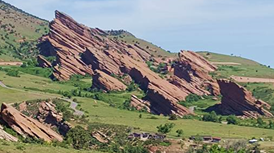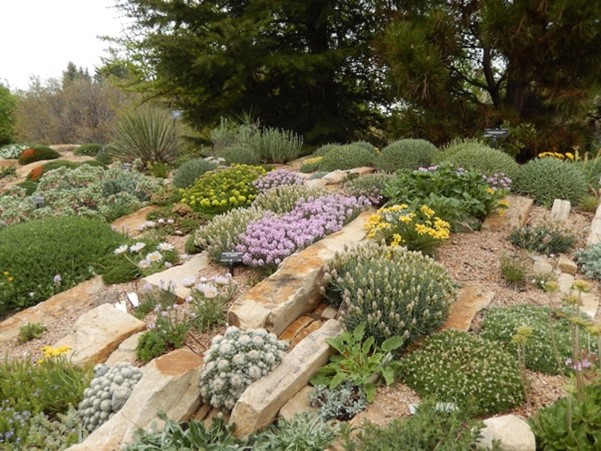Gardening in the Cracks
- 2024-05-02
- By mkirk
- Posted in Horticulture, The Garden Buzz
By Judy Kunz, Colorado Master Gardener

Originating in the Czech Republic in the 1980s, crevice gardening has caught on worldwide and is rapidly becoming a popular garden design in Colorado. Because of our high altitude and semi-arid climate, crevice gardens can thrive here with less water and maintenance than traditional gardens. The design of rock slabs in a vertical position provides a cool environment for plant roots during the hottest part of the year by channeling water down to the root zone. Roots stay cool and moist because they tend to grow deeply in search of water. Likewise, during the winter, plant roots are warmer because the rocks absorb and hold solar heat. In addition, this attractive design is also relatively resilient, needing less attention than many other garden designs. Since water is an increasingly scarce resource in our area, replacing a thirsty flower garden or a lush lawn with a crevice garden also makes good sense.
Simply put, crevice gardens are all about the rocks and drainage. Slabs of flat rock are arranged in a vertical fashion, several inches apart at varying heights, with soil placed in between the rocks to accommodate plants. This design can be an attractive focal point that provides visual interest and beauty while offering a water saving alternative, or it can be tucked into an empty area of the yard in need of an attractive design to fill a void.
Before beginning construction, determine which direction the garden will be facing and how sun exposure will affect it. It may be helpful to sketch out a design for reference. Avoid planting in an area where tree roots can become entangled with the rocks and plants. Also, consider placing the garden near a walking path for accessibility. For those who have properties with difficult-to-maintain lawn strips between the sidewalk and street, a crevice garden could be an attractive alternative to enhance the area.

When constructing the garden, an attractive choice is native stone. In Colorado there is an abundance of sandstone, demonstrated by stunning geologic formations such as Red Rocks, west of Denver, and Garden of the Gods near Colorado Springs. A crevice design echoes the angular position of those scenic formations. Also, the red coloration of the rocks can be a visual compliment to the green foliage of the plants. Slate and limestone are also good choices.

Mark out the shape of the garden on the intended spot. Dig down and level off the area about 6” below grade. Fill the depressed area with coarse sand for drainage, to support the weight of the garden. Mound with soil, enhancing it by digging in organic matter if the soil is heavy clay. Approximately 5-7% organic content is the maximum recommended amount. This translates to about 2” compost mixed into the soil. Because effective water percolation is key to a well-designed garden, perlite also makes a good addition to aid in drainage. Bury the stones deeply about 2-3” apart in a slanted, almost vertical position and fill the gaps with soil.

This design can create different microclimates, depending on the position of the sun during the day, so choosing appropriate plants is important. A crevice garden is the perfect environment for alpine or xeric plants. Depending on the sun exposure in different areas of the garden, consider choosing Plant Select plants, available at most independent garden centers in the metro area. Plant Select is a collaboration between Colorado State University, Denver Botanic Gardens and the green industry. All plants are evaluated at CSU’s trial gardens and carefully chosen for their ability to thrive at higher altitudes with less moisture. Many are ideal for a crevice garden environment. As a final step, mulch the plants with pebbles or pea gravel to retain moisture.
The initial investment of time and labor in creating a crevice garden will pay off later with beauty and ease of care. Have fun designing and executing your plan. You just might start a trend in your neighborhood.
For a detailed step-by-step guide on constructing a crevice garden, view this video from Penn State University.
Horticulture Resources
- Garden Buzz Archives
- CSU Extension Resources
- Colorado Master Gardener Program
- Foothills to Plains Native Plant Master Program
- Native Bee Watch Community Science Program
- The Co-Hort Blog
- PlantTalk Colorado
- Soil Testing
- Plant Select
- Emerald Ash Borer
- Japanese Beetle
- Colorado State Forest Service
- Ask an Expert

